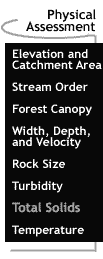
Water
Quality Assessment: Physical: Total Solids
Total solids is
a measure of the suspended and dissolved solids in water. Suspended
solids are those that can be retained on a water filter and are capable
of settling out of the water column onto the stream bottom when stream
velocities are low. They include silt, clay, plankton, organic wastes,
and inorganic precipitates such as those from acid mine drainage. Dissolved
solids are those that pass through a water filter. They include some organic
materials, as well as salts, inorganic nutrients, and toxins.
The concentration of dissolved solids in stream water is important because it determines the flow of water in and out of the cells of aquatic organisms. Also, some dissolved inorganic elements such as nitrogen, phosphorus, and sulfur are nutrients essential for life. Low concentrations of total solids can result in limited growth of aquatic organisms due to nutrient deficiencies. Elevated levels of total solids, however, can lead to eutrophication of the stream or increased turbidity. Both eutrophication and increased turbidity result in a decrease in stream water quality.
Elevated concentrations of total solids may indicate the presence of agricultural activities, dredging, or mining upstream from your sample site.
Overview ..|.. Biological Assessment ..|.. Chemical Assessment ..|.. Physical Assessment.
Elevation
and Catchment Area / Stream Order /
Forest Canopy / Width,
Depth, and Velocity / Rock Size / Turbidity
/ Total Solids / Temperature Home
..|..
Teacher Pages
..|..
Modules
& Activities
Glossary .|.
Related Links
.|..
References
..|..
PBL Model
.|
HTML code by Chris Kreger
Maintained by ETE Team
Last updated November 10, 2004
Some images © 2004 www.clipart.com
Privacy Statement and Copyright © 1997-2004 by Wheeling Jesuit University/NASA-supported Classroom of the Future. All rights reserved.
Center for Educational Technologies, Circuit Board/Apple graphic logo, and COTF Classroom of the Future logo are registered trademarks of Wheeling Jesuit University.
